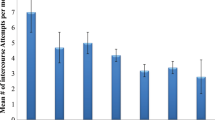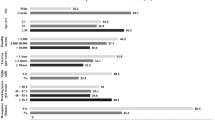Abstract
This report is based on a survey (performed 1996) of sex life in a nationally representative sample of Swedish women (n=1335) and men (n=1475) aged 18–74 y. From that survey we have previously reported on prevalence of sexual disabilities and problems caused by them.1 The main object of this article is to describe intra- and inter-gender concurrence of sexual disabilities and problems in sexually active subjects. Furthermore, the relative risk of low level of sexual well-being as predicted by sexual disabilities and distress is addressed. Respondents (59% of target sample) participated in an investigation which combined structured interviews with questionnaires/checklists. Main results are that within and across genders sexual disabilities concur to significant degrees. Of the women 48 and 26% reported at least one own and partner sexual disability or distress caused by them, respectively. For the men the corresponding proportions were 26 and 17%, respectively. Odds ratios showed that for the women low sexual interest, difficulties in obtaining orgasm and partner's early ejaculation were significant predictors of low level of sexual well-being. For the men low level of interest and partner's difficulties in obtaining orgasm were the only, but equally powerful, predictors. It is concluded that in clinical practice and for those who have a partner, sexual disabilities and distress caused by them should be regarded from the partner relationship perspective.
This is a preview of subscription content, access via your institution
Access options
Subscribe to this journal
Receive 8 print issues and online access
$259.00 per year
only $32.38 per issue
Buy this article
- Purchase on Springer Link
- Instant access to full article PDF
Prices may be subject to local taxes which are calculated during checkout
Similar content being viewed by others
References
Sjögren Fugl-Meyer K, Fugl-Meyer AR . Sexual disabilities, problems, and satisfaction in 18–74 year old Swedes Scand J Sexol 1999; 3: 79–105.
Simons JS, Carey MP . Prevalence of sexual dysfunctions: Results from a decade of research Arch Sex Behav 2001; 30: 177–219.
Ventegodt S . Sex and the quality of life in Denmark Arch Sex Behav 1998; 27: 295–307.
Bejin A . Sexual pleasures, dysfunctions, fantasies and satisfaction In: Spira A, Bajos N (eds) ACSF Group Sexual behaviour and aids Avebury: Aldershot 1994 pp 163–171.
Kontula O, Haavio-Manilla E . Sexual pleasures. Enhancement of sex life in Finland 1971–1992 Dartmouth: Aldershot 1995.
Lindal E, Stefansson JG . The lifetime prevalence of psychosexual dysfunction among 55 to 57-year-olds in Iceland Soc Psychiat Psychiatr Epidemiol 1993; 28: 91–95.
Lauman EO, Paik A, Rosen RC . Sexual dysfunction in the United States JAMA 1999; 281: 537–544.
Fugl-Meyer KS . Sexual disabilities and sexual problems In: Lewin B et al (eds) Sex in Sweden The National Institute of Public Health: Stockholm 2000 pp 199–215.
American Psychiatric Association. Diagnostic and statistical manual of mental disorders 4th edn. APA: Washington, DC 1994.
Wagner G, Béjin A, Fugl-Meyer AR, Glina S, Kimoto Y, Lukacs CSB, Mulcahy J, O'Leary M . Symptom score and quality of life In: Jardin A, Wagner G, Khoury S, Giuliano F, Padman-Nathan H, Rosen R (eds) Erectile dysfunction. WHO: Geneva 2000 pp 105–113.
Basson R et al. Report of the international consensus development conference on female sexual dysfunction: definitions and classifications J Urol 2000; 163: 888–893.
NIH Consensus Development Panel on Impotence. JAMA 1993; 270: 83–90.
Fugl-Meyer AR, Bränholm I-B, Fugl-Meyer KS . Happiness and domain-specific life satisfaction in adult northern Swedes Clin Rehab 1991; 5: 25–33.
Bejin A . Epidémiologie de l'ejaculation prématurée et de son cumul avec la dusfunction érectile Andrologie 1999; 9: 211–225.
Blanker MH et al. Correlates for erectile and ejaculatory dysfunction in older Dutch men; a community-based study J Am Geriat Soc 2001; 49: 436–442.
Viraq R, Beck-Ardilly L . Nosologie, épidémiologie, quantification clinique des dysfunctions érectils Rev Med Interne 1997; 18: (Suppl 1) 10–13.
Veenhoven R . Happy life-expectancy. A comprehensive measure of quality-of-life in nations Social Indicators Res 1996; 39: 1–58.
Acknowledgements
The authors greatly appreciate the support given by the Swedish National Institute of Public Health, in particular Kristina Ramstedt, and also acknowledge the co-authors, B Lewin, G Helmius, KA Månsson and A Lalos, of the original report (Sex in Sweden, 1998/2000).8
Author information
Authors and Affiliations
Corresponding author
Appendix
Appendix
Women
Men
Rights and permissions
About this article
Cite this article
Sjögren Fugl-Meyer, K., Fugl-Meyer, A. Sexual disabilities are not singularities. Int J Impot Res 14, 487–493 (2002). https://doi.org/10.1038/sj.ijir.3900914
Received:
Accepted:
Published:
Issue Date:
DOI: https://doi.org/10.1038/sj.ijir.3900914
Keywords
This article is cited by
-
The Heteronormativity Theory of Low Sexual Desire in Women Partnered with Men
Archives of Sexual Behavior (2022)
-
Gender Inequities in Household Labor Predict Lower Sexual Desire in Women Partnered with Men
Archives of Sexual Behavior (2022)
-
Frequency of etiological factors among patients with acquired premature ejaculation: prospective, observational, single-center study
International Journal of Impotence Research (2020)
-
Efficacy and safety of dapoxetine/sildenafil combination tablets in the treatment of men with premature ejaculation and concomitant erectile dysfunction—DAP-SPEED Study
International Journal of Impotence Research (2019)
-
Advances in understanding and treating premature ejaculation
Nature Reviews Urology (2015)



